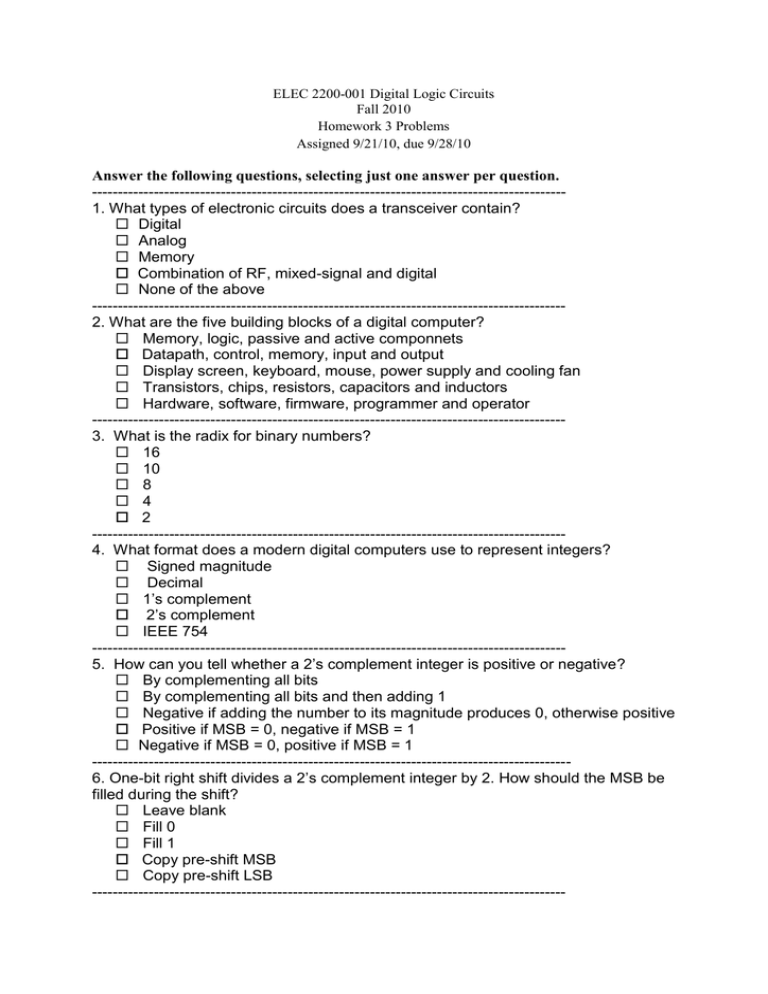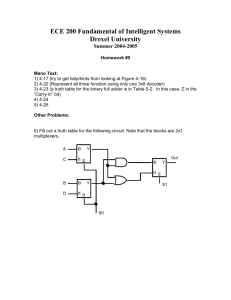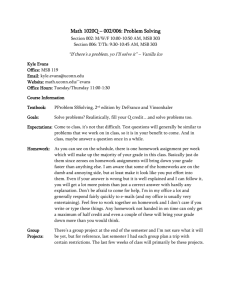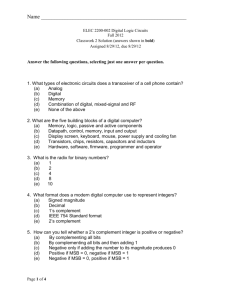-------------------------------------------------------------------------------------------- 1. What types of electronic circuits does a transceiver contain?
advertisement

ELEC 2200-001 Digital Logic Circuits Fall 2010 Homework 3 Problems Assigned 9/21/10, due 9/28/10 Answer the following questions, selecting just one answer per question. -------------------------------------------------------------------------------------------1. What types of electronic circuits does a transceiver contain? Digital Analog Memory Combination of RF, mixed-signal and digital None of the above -------------------------------------------------------------------------------------------2. What are the five building blocks of a digital computer? Memory, logic, passive and active componnets Datapath, control, memory, input and output Display screen, keyboard, mouse, power supply and cooling fan Transistors, chips, resistors, capacitors and inductors Hardware, software, firmware, programmer and operator -------------------------------------------------------------------------------------------3. What is the radix for binary numbers? 16 10 8 4 2 -------------------------------------------------------------------------------------------4. What format does a modern digital computers use to represent integers? Signed magnitude Decimal 1’s complement 2’s complement IEEE 754 -------------------------------------------------------------------------------------------5. How can you tell whether a 2’s complement integer is positive or negative? By complementing all bits By complementing all bits and then adding 1 Negative if adding the number to its magnitude produces 0, otherwise positive Positive if MSB = 0, negative if MSB = 1 Negative if MSB = 0, positive if MSB = 1 --------------------------------------------------------------------------------------------6. One-bit right shift divides a 2’s complement integer by 2. How should the MSB be filled during the shift? Leave blank Fill 0 Fill 1 Copy pre-shift MSB Copy pre-shift LSB -------------------------------------------------------------------------------------------- Page 2 of 3 7. One-bit left shift multiplies a 2’s complement integer by 2. How should the LSB be filled during the shift? Leave blank Fill 0 Fill 1 Copy pre-shift MSB Copy pre-shift LSB -------------------------------------------------------------------------------------------8. What is the negation rule for 2’s complement numbers? Invert the MSB Invert all bits Invert all bits and add 1 Change MSB to 1 Invert all bits and subtract 1 -------------------------------------------------------------------------------------------9. What indicates overflow when two n-bit 2’s complement integers are added? A carry of 1 is generated when MSB’s are added Two numbers being added have opposite signs Two numbers being added have the same sign The two numbers have the same MSB, which differs from the MSB of sum None of the above -------------------------------------------------------------------------------------------10. Which is the fastest n-bit adder circuit? Ripple-carry adder, time complexity O(n) Carry-skip adder; time complexity O(√n) Carry look-ahead adder; time complexity O(log2n) Carry-select adder; time complexity O(√n) None of the above -------------------------------------------------------------------------------------------11. What is the critical path of a digital circuit? Input to output path with largest number of gates Input to output combinational path with longest delay Path that is always active Path that is never active Fastest signal path between input and output -------------------------------------------------------------------------------------------12. What is the number of bits needed to hold the product of two n-bit 2’s complement integers? n More than n 2n n +1 n2 -------------------------------------------------------------------------------------------13. What is the time complexity of an array multiplier? O(n) O(n2) O(n1.5) O(n log n) Exponential in n -------------------------------------------------------------------------------------------- Page 3 of 3 14. How many iterations does binary division of n-bit integers require? 1 Many until the result converges n/2 Exactly n n2 -------------------------------------------------------------------------------------------15. What is the Hamming distance between two n-bit binary vectors? Cartesian distance between the tips of the two vectors Manhattan distance 0 ≤ Hamming distance ≤ n Number of bits in which the two binary vectors match Number of bits in which the two binary vectors differ -------------------------------------------------------------------------------------------16. How many error bits can a single parity bit detect? Any odd number Any even number 1 2 None -------------------------------------------------------------------------------------------17. What is the bias used for the exponent of an IEEE 754 floating point number? None 255 – 255 Biased exponent = true exponent – 127 Biased exponent = true exponent + 127 -------------------------------------------------------------------------------------------18. How will you determine the sign of an IEEE 754 floating point number? All numbers above certain threshold are negative MSB = 0 for negative, MSB = 1 for positive MSB = 0 for positive, MSB = 1 for negative Always positive Cannot tell -------------------------------------------------------------------------------------------19. What is the decimal value of the 32-bit floating point number, 1 10000001 1100 0000 0000 0000 0000 000, represented in the IEEE 754 format? 7.0 – 7.0 Negative 0 Negative infinity 0, due to underflow -------------------------------------------------------------------------------------------20. How are two floating point numbers in IEEE 754 format multiplied by a digital circuit? Both numbers converted to integers and multiplied Convert multiplier to integer and add multiplicand to itself that many times Numbers converted to logarithms and added Multiply significands, add exponents, normalize, roundoff, add sign (corrected) Cannot be done





